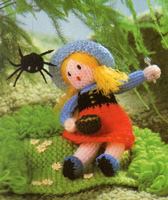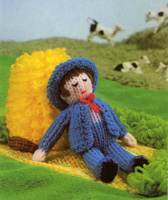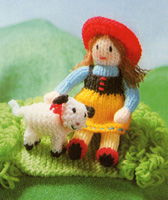About Us
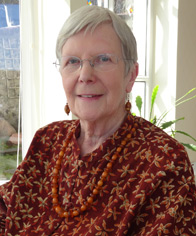
Jean Greenhowe Designs are publishers of knitting pattern booklets for dolls
and toys.
The company was formed in 1988 and is owned and run by Jean Greenhowe and her
family.
Everything we produce is designed exclusively by Jean. We
do not have a design team and we do not publish work by other designers.
Jean began her career in the 1960s designing fashion garments
for Vogue Knitting.
In
1967 she joined Woman’s Weekly magazine as their craft features writer
and designer. Jean remained with the magazine for 24 years, producing
hundreds of designs in a wide variety of crafts. In fact, her designs
became so popular that a Jean Greenhowe feature guaranteed a sell-out and in
the 1980s Woman’s Weekly circulation rose to 1.3 million.
During these 24 years Jean also wrote 19 craft books, including ‘Knitted
Toys’ which was one of the best-selling knitting books ever written.
In 1988 she established her own company Jean Greenhowe Designs, which went
on to become one of the most successful publishers of knitting patterns in
the world.
How Jean Greenhowe Revolutionised the Designing of Knitted Dolls and Toys
I am sometimes asked where I trained to design all the things I have produced in my career. The short answer is, I have never had formal tuition relating to any part of my work. My only official credential is a school certificate on leaving High School. I got good results in eight different examinations, with a distinction in art which had always been my best subject.
On leaving school our art teacher Miss Bell assumed that I would progress to art school. Her comment on my final report, ‘I do hope that she will continue to develop her gift’. I didn’t go to art school or art college for which I am now most grateful. With formal art tuition it is unlikely that I would be doing what I do today, Miss Bell could never have imagined the outcome!
My reasoning is as follows. Knowledge and techniques which are already known can be passed on to others. Any new ideas and inventions yet to come in the future don’t rely upon teaching, they depend upon the imagination of individual creators. Anyone can be taught techniques to improve skills thereby encouraging creativity, but I don’t believe that anyone can be taught to produce original work.
Here is how I accidentally got into soft toy design. Around about 1960, I found some toy patterns for cats and kittens in a magazine. They were attractive and I made them. There were lots of elaborately-shaped pieces and gussets which had to be sewn together, but this wasn’t a problem because I had been dressmaking and tailoring clothes for myself and my family for years.
However, I wondered why these toys were so complicated and here’s the important crux of the matter. At that time I wasn’t aware that the methods used for the cats and other soft toys were already well established as far back as the Victorian era. I eventually came across a pattern for a toy elephant published in a magazine dated 1879 which showed that the sophisticated soft toy cats’ techniques must have been in use years before that date.
But in the 1960s I was completely unaware of these facts because no-one told me about the methods or taught me the techniques. Because I didn’t know that these rules existed I unwittingly broke them and began to experiment with doll and toy designs.
| |
Note:
Many years later I came across a book published in 1971 about designing soft toys, which followed the established methods. The technique is described as ‘profile and gusset construction’, from which three-dimensional toys can be produced. The majority of manufactured soft toys are created in this way. Below, there is an example of the patterns for a horse from the 1971 book. The ‘profile’ of the horse is easily recognisable and as shown there are numerous elaborately shaped pieces.
|

Back to the 1960s and ‘rule-less’ I was creating my own methods for soft dolls and toys and the designs were subsequently published in various magazines. My first Woman’s Weekly toys were featured in the magazine in 1967 as a special offer paper pattern. Below is the photograph of the soft toy book author’s realistic horse, alongside my Woman’s Weekly Cowboy and his Horse.
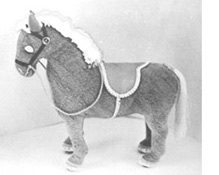
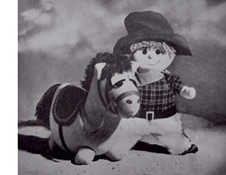
The author’s horse is a complicated and exact representation of a real-life horse. My horse is recognisable as such, but his legs are short and stumpy and he stands up on his tummy, everything is easy to make and I’m sure you’ll agree that he is comically entertaining. The pattern sold like hot cakes and established the foundation of all my work for the magazine for the next 24 years.
In 1983 I was asked to repeat the Cowboy and Horse so I made some changes and also included an Indian and his Pony. The special offer pattern was featured in Woman’s Weekly 17 September 1983 and again ‘hot cakes’.
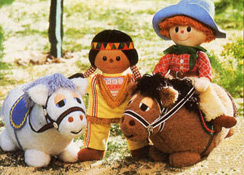
Another spark to my imagination was the limited amount of space available for toy patterns in magazine features. So I began to devise methods of producing toys without using any pattern pieces, just measurements in the instructions. Here are two examples out of many. Below are twelve soft toy animals, which don’t require patterns. Without any ‘profile and gusset’ complications they are all still recognisable as to what they represent.
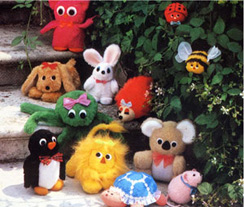
One of my favourites follows – Morwenna Mermaid and friends and again, not a single printed pattern in sight.
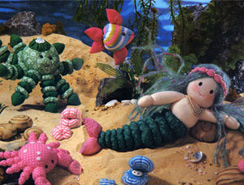
My 19 hardback toy-making books also featured some unusual subjects.
Musical boxes are usually constructed from wood. ‘Making Musical Miniatures’ was published in 1979 and included 27 musical items for every occasion - no carpentry required, they are all fashioned from cardboard.

In the circular miniatures the platforms revolve as the music plays and for others the individual figures revolve in the same way. All the movement is achieved through the musical movement winding keys. I think it unlikely that anyone else has produced a similar publication.
I also designed several dolls’ houses, again using cardboard and other throw-away household items for the furnishings. Probably my most amusing ‘dolls’ house was made for a tiny Dormouse family, entirely constructed from fabric – one of my all-time favourites.
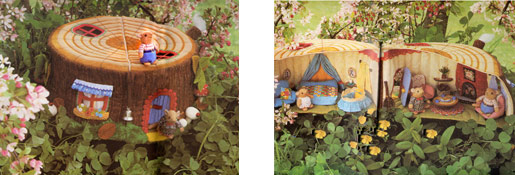
And so the new ideas carried on through time, featuring everything from children’s fancy dress to play-houses, jewellery and printed fabric dolls and toys to cut out and sew.
Then in 1980 I designed my first knitted dolls …
From the evidence I have accumulated regarding the history of toys and dolls in general, I have not found any historical documented references for the production of knitted doll and toy patterns. There are numerous sources for these investigations, but one will suffice.
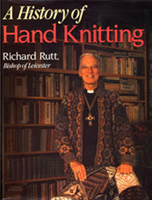 ‘A History of Hand Knitting’ was published by B. T. Batsford in 1987. Written by Richard Rutt, (then Bishop of Leicester) this is an outstanding, scholarly work, researched over a period of ten years. It is impossible to summarise the 248 pages of the History in a Newsletter. Therefore, I will only refer to the details which are relevant to knitted toys. There is an interesting and informative section regarding charity knitting, which began in the Victorian era (and as we know has continued into the 21st century). However, the History was published in 1987 and Richard Rutt particularly mentions small items made for charity during the 1980s, the period when he was writing the book.
‘A History of Hand Knitting’ was published by B. T. Batsford in 1987. Written by Richard Rutt, (then Bishop of Leicester) this is an outstanding, scholarly work, researched over a period of ten years. It is impossible to summarise the 248 pages of the History in a Newsletter. Therefore, I will only refer to the details which are relevant to knitted toys. There is an interesting and informative section regarding charity knitting, which began in the Victorian era (and as we know has continued into the 21st century). However, the History was published in 1987 and Richard Rutt particularly mentions small items made for charity during the 1980s, the period when he was writing the book.
‘…the quality of design is very poor. Teacosies, toilet-roll covers and toys comprise the bulk of the output …’
There are no previous references to knitted toys or toy patterns in the History.
I have a large collection of knitting books, booklets, magazines and leaflets, dating from 1856 to the present day. The earliest featuring toys was published around 1930. The 1930s and 1940s patterns for toys are relatively scarce when compared with the huge volume of garment patterns. The following evidence demonstrates the lack of toy patterns.
Jane Koster and Margaret Murray were prolific knitwear designers in the 1940s and together they produced eight hardback books which I have in my collection.
Each book contains an average of 60 garment patterns for the family, and household items such as table mats and hot water bottle covers. Out of a total of 480 patterns, only one is for a toy - a knitted duck, published in the 1940 edition. More about this pattern later.
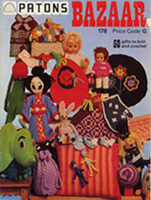
In the 1940s knitting patterns were featured in women’s magazines and the yarn manufacturers also published numerous patterns to promote sales of their products. During the 1950s and 1960s the quantity of garments produced resulted in small bits of yarn left over from every project. So the manufacturers began to publish ‘bazaar’ booklets and leaflets with patterns for small items such as tea cosies, cushion covers, dolls and toys, for using up the oddments. The booklet shown here is from the 1960s. These patterns were only produced as an ‘economy’ service to knitters and unlike garment patterns, they were of no importance in the knitting industry.
Tea cosies and other useful related items had always been part of traditional knitting craft since the first patterns were published in the nineteenth century. But when the first toy patterns were introduced at some unknown date in the past there weren’t any established methods for creating three-dimensional objects, so who designed these toys and how did they go about it? I have not found any credited names in the oldest patterns, but it can be presumed that they were produced by garment designers and perhaps home-based knitters. As to the construction, from my research it is evident that the majority of patterns were copied from commercial paper patterns for rag dolls and soft toys which had been available since the Victorian era.
The toy pieces in these knitting patterns were most frequently worked in garter stitch which lies flat, indicating that they were reproduced from flat paper pattern shapes. The Murray/Koster duck mentioned previously is a ‘paper pattern’ production. It is made from four separate pieces and knitted in moss stitch, which also lies flat like garter stitch.
Before the advent of computer technology knitted garments were designed on graph paper. Therefore, the soft toy paper patterns could be turned into knitting patterns by transferring each piece onto the squared paper. Although the paper shapes had smooth continuous edges, the graph versions would have been translated into steps for the increases and decreases and the straight lines became cast on and cast off edges. All the knitted shapings were at the outer edges of the pieces. The finished graphs could then be used to write line-by-line instructions, according to the yarn and the required knitted tension.
Below are some of the diagrams for a 1990s knitted animal, with steps etc as described above. Alongside, there is a graphed diagram for the placement of two star motifs on a knitted sleeve, which also shows the stepped row-by-row shaping.
|
With regard to designing knitted garments, it is interesting to note that the paper pattern technique was described in two early documents. In a knitting book dated 1912 regarding knitted garment construction:-
‘Many knitters are unable to follow long patterns
with detailed instructions … the new method is
to follow paper patterns.’
And in a knitting book dated 1939, there is extensive advice on:-
‘Knitting from dressmakers’ patterns.’
All this may appear to be obvious regarding the design of garments but the evidence also proves that without any other options the method was subsequently adopted for the design of knitted toys.
Poor Quality
Back to Richard Rutt’s comment on poor quality of design in the knitted bazaar items. The paper pattern toys were unsatisfactory because they were produced using methods specifically intended for woven fabrics. Woven material stretches across the bias (the diagonal direction) whereas knitting is a loop-in-loop process which is naturally elastic and stretches in every direction.
This elasticity is what makes knitting uniquely suitable for the construction of comfortable garments.
With woven fabric toys, the pattern pieces can 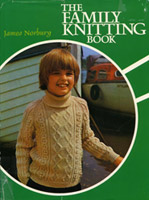 be adjusted to control the bias stretch effect when stuffed. In contrast, the copied knitted toys would have to be stuffed very lightly to avoid distorting the knitted shapes.
be adjusted to control the bias stretch effect when stuffed. In contrast, the copied knitted toys would have to be stuffed very lightly to avoid distorting the knitted shapes.
Examples
In order to show a few ‘poor quality’ toys I have chosen The Family Knitting book by James Norbury, published by Hamlyn in 1969. James Norbury was a notable British knitwear designer, active from the 1940s to 1960s. He was Patons’ head designer for many years, appeared in television series and travelled the world researching the history of knitting. What Norbury didn’t know about knitting wasn’t worth tuppence.
The Family Knitting Book contains 290 pages and features beautiful classic garments which haven’t dated one bit.
The book has various chapters, one of which is titled ‘Ideas for Christmas Presents’. As well as the usual items such as tea cosies, slippers and a cushion cover there are several patterns for dolls and toys. Three of the toys are shown below.
The majority of the knitted pieces are worked in garter stitch and the flat construction indicates that they were probably derived from paper patterns. It can be assumed that James Norbury would not have been involved in the production of these toy patterns. His garments are masterpieces of design in every respect. The toys don’t come anywhere near the same standard but patterns for toys would be expected in the Christmas chapter and obviously there were no better alternatives.
My First Knitted Toys
I had always been aware that knitted dolls and toys were the poor relations in the world of knitting. I also knew that it was possible to devise new and more appropriate methods of construction. My knitting experience in designing garments and working in three-dimensions with soft toys for almost twenty years could be incorporated into knitted toys.
Many of my rag dolls were made from stockinet (T-shirt fabric) which added to the possibilities of utilising the stretchiness of hand-knitted fabric, to make it work as part of the overall design.
At the beginning of 1980 I began the first experiments. I decided to use smaller needles than usual for double knitting yarn and made numerous stuffed samples in order to gauge the stretch.
These preliminaries took a long time. With my woven fabric dolls and toys the basic materials came ready-made. When designing a rag doll, I made trial paper patterns, cut out and stuffed the pieces, then the patterns could be refined and re-made as necessary. But with the knitted toys everything had to be made from scratch – a case of ‘first knit your fabric’. And at the same time the pieces required shaping as the work progressed.
Then the end-result of each test could only be judged when the pieces were stitched and stuffed and so the process had to be repeated many times over, constantly exploring innumerable possibilities.
Eventually, I had a good pattern for a basic doll which developed into ten different characters. The dolls were featured in two Woman’s Weekly issues – 27 September and 4 October 1980. Our readers responded with enthusiasm and asked for more.
It is obvious that my dolls don’t look anything like the 1969 toys shown earlier. Apart from the overall appearance, what made the difference?
First, I used the stretch factor to advantage as an important part of the construction. Secondly, instead of garter stitch ‘shaped at the edges’ pieces, I worked in stocking stitch and shaped within the knitted pieces. This introduced a knitted-in three-dimensional aspect.
To illustrate this three-dimensional effect here is one of my later dolls before sewing-up and stuffing. The knitted piece cannot be flattened because there are irregular bumps and depressions caused by the integral shaping. These bunched-up repeats of increases and decreases would not have been appropriate in garment designs. Therefore, in relation to traditional knitting techniques this development was somewhat revolutionary.

My Woman’s Weekly basic doll only required 5 pieces, whereas a ‘paper pattern’ knitted doll could have as many as 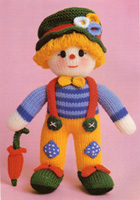 20 separate pieces. But one of the obvious differences in my first knitted dolls and those which had gone before was in the facial features. In the 1969 toys, the facial stitches are overworked and not very attractive. For the knitteds I applied the same methods as used for my rag dolls’ faces, which were always as simple as possible.
20 separate pieces. But one of the obvious differences in my first knitted dolls and those which had gone before was in the facial features. In the 1969 toys, the facial stitches are overworked and not very attractive. For the knitteds I applied the same methods as used for my rag dolls’ faces, which were always as simple as possible.
Progress – New Techniques
For my first knitted dolls I had used bits of felt, ric-rac, braid and ribbon for the trimmings. In subsequent designs all the trimmings and extras were knitted. Here is my 1982 Woman’s Weekly clown where every item is knitted.
I wasn’t happy using felt eyes for my knitted toys and in 1983 I began to work the facial stitches using yarn. Below, three Nursery Rhyme scenes where two of the dolls have chain-stitch eyes. With these dolls I also began to give instructions for the placement of facial stitches, by including counted knitted rows and stitches in the patterns.
Snow White and the Seven Dwarfs were published in Woman’s Weekly 5th October 1985. For Snow White I devised a method by which the feet, legs, body and head were all knitted in one piece. The off-centre shaping of the feet and the positions of the inside leg seams made the feet naturally point forward. I also introduced another method for the eyes, using knots tied in lengths of yarn.

And so the developments continued in my knitted doll and toy features for Woman’s Weekly. Then in 1988, I established Jean Greenhowe Designs in order to concentrate entirely on the knitteds and to publish my patterns in booklet form. I think it is possible that I was the first designer/publisher to specialise exclusively in patterns for knitted dolls and toys and the advantage of publishing my own work gave me complete control of the entire production.
This freedom of choice also allowed me to spend time experimenting with fresh ideas and techniques and in the following years my methods evolved with each design. I have written a detailed account of the inventions and my working procedures stage-by-stage but it is far too long to include in a Newsletter.
As to ‘history’, I hope that my dolls and toys have opened up a new chapter and established their own unique place in knitting history.











 ‘A History of Hand Knitting’ was published by B. T. Batsford in 1987. Written by Richard Rutt, (then Bishop of Leicester) this is an outstanding, scholarly work, researched over a period of ten years. It is impossible to summarise the 248 pages of the History in a Newsletter. Therefore, I will only refer to the details which are relevant to knitted toys. There is an interesting and informative section regarding charity knitting, which began in the Victorian era (and as we know has continued into the 21st century). However, the History was published in 1987 and Richard Rutt particularly mentions small items made for charity during the 1980s, the period when he was writing the book.
‘A History of Hand Knitting’ was published by B. T. Batsford in 1987. Written by Richard Rutt, (then Bishop of Leicester) this is an outstanding, scholarly work, researched over a period of ten years. It is impossible to summarise the 248 pages of the History in a Newsletter. Therefore, I will only refer to the details which are relevant to knitted toys. There is an interesting and informative section regarding charity knitting, which began in the Victorian era (and as we know has continued into the 21st century). However, the History was published in 1987 and Richard Rutt particularly mentions small items made for charity during the 1980s, the period when he was writing the book. 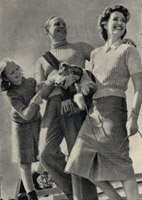
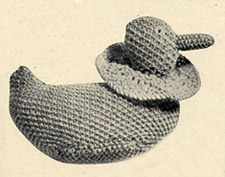
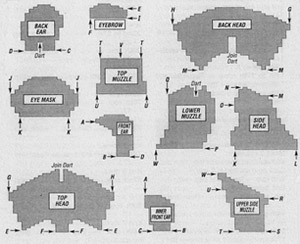
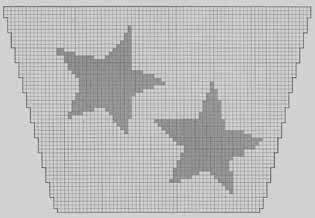
 be adjusted to control the bias stretch effect when stuffed. In contrast, the copied knitted toys would have to be stuffed very lightly to avoid distorting the knitted shapes.
be adjusted to control the bias stretch effect when stuffed. In contrast, the copied knitted toys would have to be stuffed very lightly to avoid distorting the knitted shapes. 
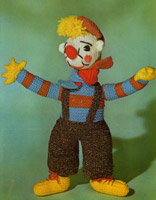

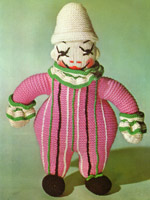
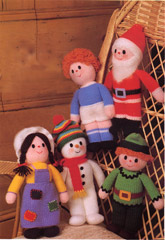
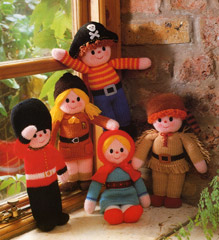

 20 separate pieces. But one of the obvious differences in my first knitted dolls and those which had gone before was in the facial features. In the 1969 toys, the facial stitches are overworked and not very attractive. For the knitteds I applied the same methods as used for my rag dolls’ faces, which were always as simple as possible.
20 separate pieces. But one of the obvious differences in my first knitted dolls and those which had gone before was in the facial features. In the 1969 toys, the facial stitches are overworked and not very attractive. For the knitteds I applied the same methods as used for my rag dolls’ faces, which were always as simple as possible.